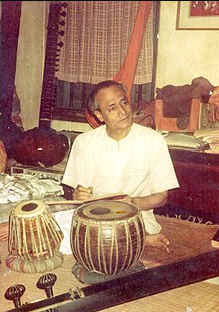Nitai Bose
Nitai Bose | |
|---|---|
 | |
| Background information | |
| Birth name | Nitai Bose |
| Born | 26 May 1927 Kolkata |
| Died | 5 March 2019 (aged 81) Kolkata |
| Genres | Indian classical music |
| Occupation(s) | Musician |
| Instruments | Sitar |
| Years active | – 2009 |
Nitai Bose (26 May 1927 – 5 March 2019) was a Bengali sitar player and musician, who was an exponent of Jaipur Senia gharana.
Family and childhood
Nitai Bose's father was Ramendra Kumar Bose and mother was Umarani Dutta. His grandfather was Nagendra Kumar Bose and great grandfather was Harish chandra Bose. Earlier, this Bose family used to live on the Vrindavan street of current Ahiritola in Kolkata. Nagendra Kumar Bose and his brother Gunendra Kumar Bose bought the house at 20/1 Raja Manindra Road in Paikpara, where Nitai Bose lived till his last day. Deependra Kumar Bose, the son of Gunendra Kumar Bose, was an accomplished painter, whose paintings on Chaitanya series are still preserved in the Academy of fine arts, Kolkata and paintings on Durga series are preserved in the Ramakrishna Mission Institute of Culture at Golpark in Kolkata. His painting on six ragas] and thirty-six raginis used to decorate the wall of Nitai Bose's room till the latter's last day of life. Nitai Bose had seven brothers and six sisters. Their mother Umarani was the daughter of Atul Chandra Dutta and Binapani Dutta. Atul Chandra's father, Kalikadas Dutta was financial minister of the king of Cooch Behar, Nripendra Narayan. Kalikadas was a signifact figure in whose name a road in Kooch Bihar was named, and that road still exists. Kalikadas had three sons. Eldest son was Atul Chandra Dutta, middle son Charu Chandra Dutta was an intimate fried of Sri Aurobindo, and youngest son Naresh Chandra Dutta was a sitar player. The influence of the youngest uncle Naresh Chandra was instrumental in the manifestation of Nitai Bose's inherent artistic disposition. Umarani's uncles used to live in the Mitra residence of Jhamapukur, where there was sacred establishment of 'Jora Gopal Jiu'. Umarani's mother Binapani was a disciple of Sri Bholananda Giri (Bholagiri). Binapani was given the name 'Jatiya Ma' by Bholagiri. In fact, she was known by the names 'Gopal Ma' and 'Jatiya Ma'.
Musical life
Nitai Bose's first musical training was from uncle Naresh Chandra Dutta. After that he started learning Sitar and music from Ustad Mushtaq Ali Khan of Senia gharana. Later he became one of the six disciples whom Mushtaq Ali Khan accepted as his Ganda-bandh disciple through Ganda Bandhan [1]. After graduating with B.A. degree from Scottish Church College, he participated in a number of music competitions within and outside Kolkata, and secured the first place in almost all of them. He earned the appreciation and praise of virtuous and distinguished musicians by playing sitar in Dover Lane Music Conference, Bengal Music Conference, and many other conferences inside and outside Bengal. Yet later he voluntarily withdrew himself from the limelight. He could also play other instruments. Perhaps he is the only sitar player who used to play sitar wearing mizraab in the middle finger of the right hand. Besides Hindustani Classical music, he used on listen to other types of music as well, national or international. He had an international appreciation in listening. However, while playing sitar he was an orthodox and loyal representative of Senia gharana as for that he was committed to his guru Mushtaq Ali Khan.
Impact
Nitai Bose used to live in their family residence at 20/1 Raja Manindra Road in Paikpara, Kolkata. Beside his house was the house of renowned Bengali writer and poet Narendranath Mitra [2]. The story called 'Sitar' written by Narendranath Mitra was based on the life of Nitai Bose. Although Bose shunned publicity, by the attraction of his extraordinary erudition and at the same time a charming personality coupled with a kind and cheerful countenance, both renowned and unknown musicians and artists used to come to his house [3]. As distinguished ustads would come, so also contemporary modern artists would come. Bose used to listen to all lovingly giving due importance and respect, and used to give inspiration and confidence to those who needed.
Teaching and philosophy
- While trying to elucidate some raga, or gayaki, he used to demonstrate by singing songs.
- He used to say -- when a person first attempts to sing, the sound that comes out from the throat is neither too high-pitched nor too low-pitched, rather in the middle. He loved to play in medium tempo, and that was his teaching. He used to consider it a matter of mastery to express Marga Sangeet fully in the medium tempo.
- He used to say -- skill is very important, yet one must see that skill does not consume oneself. Whatever raga you are playing or whatever song you are singing, you are to become one with that raga or that song such that you yourself become a living raga or song. To reach this place is the goal.
Albums
Raga Malkauns, Bhairavi (US, 2001), IAM CD 1047
References
- ↑ Ustad Mushtaq Ali Khan - Ekti Anweshan, A Documentary Film by Jayanta Chattopadhyay
- ↑ An interview with tabla player Samir Chatterjee
- ↑ [http://kolkatamusicmapping.com/arjun-shejwal/ A Bengali interview with writer and music connoisseur Debabrata Mukhopadhyay
This article "Nitai Bose" is from Wikipedia. The list of its authors can be seen in its historical. Articles taken from Draft Namespace on Wikipedia could be accessed on Wikipedia's Draft Namespace.